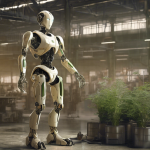
Humanoid Robots Are Entering Your Workplace: What You Need to Know
The future of work is arriving faster than you might think. Humanoid robots—machines with human-like bodies designed to perform physical tasks—are moving beyond prototypes and into real workplaces right now.
The global humanoid robot market reached $1.58 billion in 2024 and is projected to grow at a 15.57% CAGR, reaching $6.72 billion by 2034. Some projections even suggest a staggering $200 billion market by 2035. This growth is fueled by unprecedented investment, with venture capital funding expected to hit $3 billion in 2025.
The most significant impact will be in logistics, manufacturing, healthcare, and retail sectors, where robots are already being deployed for specific tasks. Companies like Amazon, GXO Logistics, BMW, and Ford have implemented pilot programs using humanoid robots for material handling and inventory management.
What does this mean for workers? The relationship between robots and jobs is nuanced. While 23.5% of US companies using AI have replaced some workers, the World Economic Forum projects 97 million new roles by 2025 to offset 85 million displaced jobs.
To thrive in this new environment, workers need to develop both technical skills (robotics fundamentals, data analysis) and soft skills (communication, adaptability, problem-solving). The most successful organizations will be those that view humanoid robots not as replacements for humans, but as tools that allow people to focus on higher-value activities requiring creativity, judgment, and interpersonal skills.
For more in-depth insights on this topic, check out Oliver's comprehensive analysis here: The Rise of Humanoid Robots: Reshaping the Modern Workplace
How is your industry preparing for the integration of humanoid robots? Are you developing the skills needed to work alongside them?
If you found this valuable, please share it with colleagues who need to prepare for this workplace transformation.


